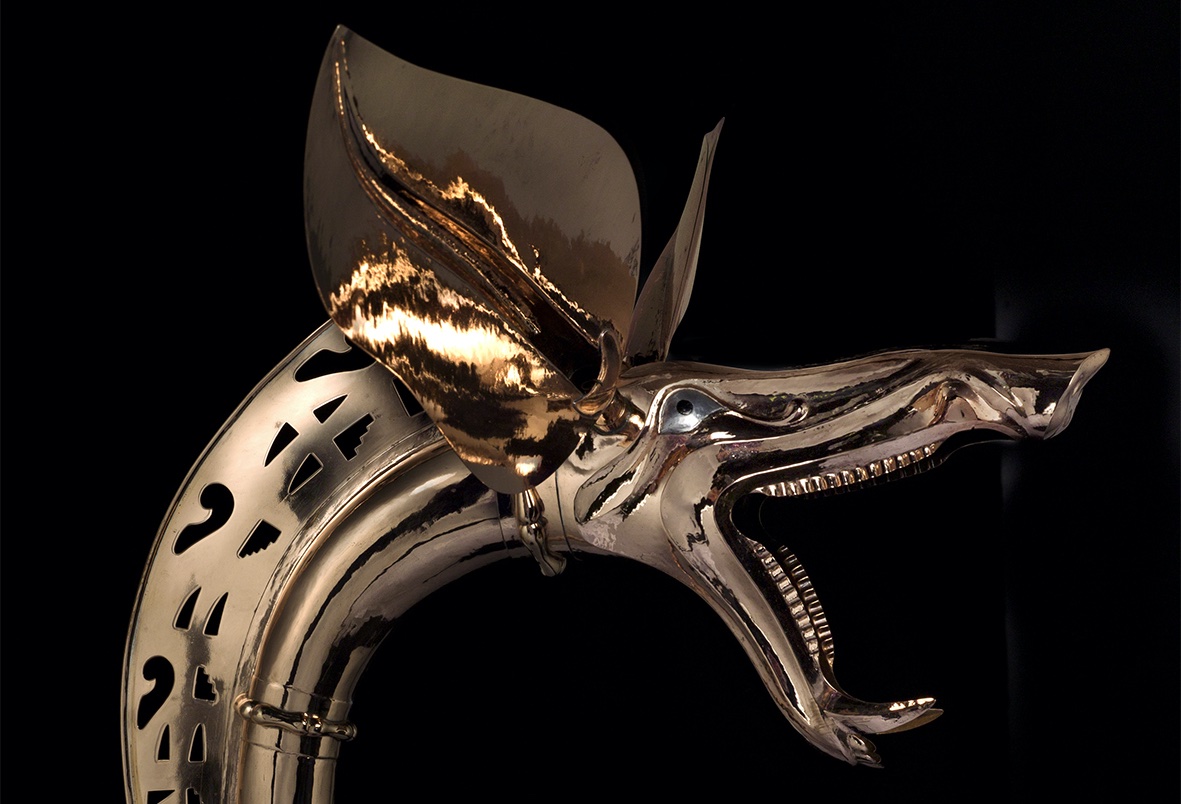– the Gundestrup Cauldron brought to life!

Dragon Voices perform music on multiple instruments, including trombones, sackbuts, Deskford Carnyx, Tintignac Carnyx, Loughnashade Horn, Alphorn, Conch shells, animal horns, pod trumpets, and Etruscan litus and cornu – a unique experience of hearing the great horns of the ancient Celtic and Etruscan world played in ensemble.
Patrick Kenny grew up in Edinburgh with the voice of the carnyx in his ears. Already a busy freelance trombonist and composer, he made his televised debut performance on the Deskford Carnyx at the age of 22 for the re-opening of the National Museum of Scotland in Edinburgh in 2011, and has since gone on to perform internationally on the instrument both as a soloist and in duo with his father John Kenny. As members of the European Music Archaeology Project, Patrick and his father John have performed as Dragon Voices duo throughout Europe, and in May 2017 made their CD debut on the album Set Upon the Rood, (Delphian Classics 34154) in John Kenny’s “The Deer’s Cry” for Deskford Carnyx, Loughnashade Horn, and the choir of Gonville & Caius College, Cambridge, directed by Geoffrey Webber.

In 2022 they were joined by Ian Sankey, also a leading trombone soloist and composer based in Newcastle upon Tyne, to give the world premiere of Gundestrup Rituals by John Purser at the Cumnock Tryst Festival, directed by Sir James MacMillan.
The Gundestrup cauldron is a richly decorated silver vessel, thought to date from between 200 BC and 300 AD. This places it within the late La Tène period of Celtic culture, and it is the largest known example of European Iron Age silver work (diameter: 69 cm, height: 42 cm. Both its interior and exterior surfaces heavily decorated with repouss’ work, hammered from beneath to push out the silver, as well as extensive gilding and some use of inlaid pieces of glass for the eyes of figures. The cauldron was found in Denmark, not made there or nearby; it includes elements of Gaulish and Thracian origin in the workmanship. The cauldron’s imagery is a mysterious blend Celtic pantheon, and Celtic mythology with iconography wich seems to be derived from the art of the ancient Near East, and there are intriguing parallels with ancient India and later Hindu deities and their stories. However, among the most specific details that are clearly Celtic are the group of three carnyx players, and this image was crucial to the reconstruction of the Deskford Carnyx, and the starting point of our understand of how it might be held and played.
In the Gundestrup image a line of warriors bearing spears and shields marching to the left towards a giant horn headed figure, followed by a warrior with no shield, bearing a sword, and wearing a boar-crested helmet. Behind him are three carnyx players. In front of this group a dog leaps up, perhaps holding them back. The horned giant holds a man upside down, apparently with ease, and apparently is about to immerse him in a barrel or cauldron. Above this ceremonial procession a tree lies horizontal, and above this, perhaps symbolically in a other world, warriors on horseback with crested helmets and spears ride away to the right, led by a horned serpent. Significantly, the heads of the carnyx are above the tree which separates the lower and upper worlds. This is not a scene of battle, but a ritual in which fallen warriors are dipped into a cauldron to be reborn into their next life, or afterlife.

It was to the remarkable polymath John Purser that we owe the rebirth of the Carnyx. Composer, musicologist, broadcaster, poet and playwright – In 1991 John Purser initiated and directed the project which led to the reconstruction of the Deskford Carnyx. Thirty years later, with the generous support of the William Grant Foundation, Carnyx & Co was able to commission a 3rd Deskford Carnyx and commission the Purser’s music and poetry for Gundestrup Rituals, animating those mysterious and compelling images with three carnyces for the first time in 2,000 years.


